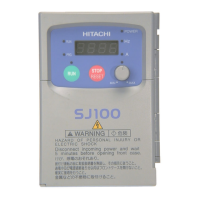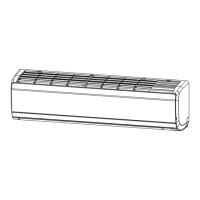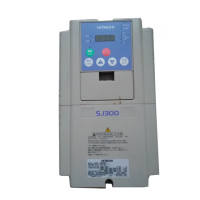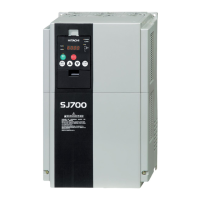SJ100 Inverter
Appendix A
A–7
Stator
The windings in a motor that are stationary and coupled to the
power input of the motor. See also rotor.
Tachometer
1. A signal generator usually attached to the motor shaft for the
purpose of providing feedback to the speed controlling device of
the motor. 2. A speed-monitoring test meter which may optically
sense shaft rotation speed and display it on a readout.
Thermal Switch
An electromechanical safety device that opens to stop current flow
when the temperature at the device reaches a specific temperature
threshold. In variable-speed drive systems, thermal switches are
typically installed at or near the motor, in order to protect the
windings from heat damage.
Three-phase
An AC power source with three Hot connections that have phase
offsets of 120 degrees is a 3-phase power source. Usually, Neutral
and Earth Ground wires accompany the three Hot connections.
Loads may be configured in a delta or Y configuration. A Y-
connected load such as an AC induction motor will be a balanced
load; the currents in all the Hot connections are the same. There-
fore, the Neutral connection is theoretically zero. This is why
inverters, which generate 3-phase power for motors, do not gener-
ally have a Neutral connection to the motor. However, the Earth
Ground connection is important for safety reasons, and is provided.
Torque
The rotational force exerted by a motor shaft. The units of measure-
ment consist of the distance (radius from shaft center axis) and
force (weight) applied at that distance. Units are usually given as
pound-feet, ounce-inches, or Newton-meters.
Transistor
A solid state, three-terminal device that provides amplification of
signals and can be used for switching and control. While transistors
have a linear operating range, inverters use them as high-powered
switches. Recent developments in power semiconductors has
produced transistors capable of handling hundreds of volts and tens
of Amperes or more, all with high reliability. The saturation voltage
has been decreasing, resulting in less heat dissipation. Hitachi
inverters use state-of-the-art semiconductors to provide high perfor-
mance and reliability, all in a compact package. See also IGBT and
saturation voltage.
Trip
An event which causes the inverter to stop operation is called a
“trip” event (as in tripping a circuit breaker). The inverter keeps a
history log of trip events. They also require an action to clear.

